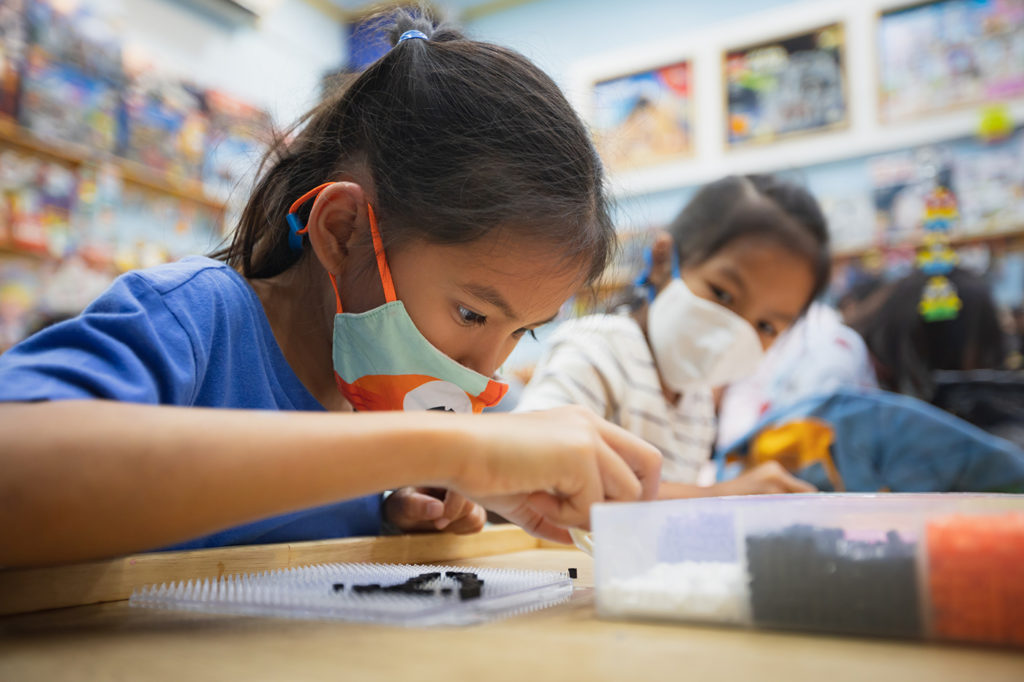
California’s indoor masking order for schools will be downgraded to a strong recommendation after March 11, state officials announced on Monday.
In a joint news release, the governors of California, Oregon and Washington cited declining case rates and hospitalizations as the basis for easing face-covering requirements for students and staff on public and private school campuses. The new guidance also applies to child care facilities.
Local jurisdictions may continue their masking requirements based on conditions impacting their communities, and students and staff may still choose to wear masks. But they will no longer be a state requirement after 11:59 p.m. on Friday, March 11.
“California continues to adjust our policies based on the latest data and science, applying what we’ve learned over the past two years to guide our response to the pandemic,” Gov. Gavin Newsom said in a statement. “Masks are an effective tool to minimize spread of the virus and future variants, especially when transmission rates are high. We cannot predict the future of the virus, but we are better prepared for it and will continue to take measures rooted in science to keep California moving forward.”
The announcement came three days after the U.S. Centers for Disease Control and Prevention said it was no longer recommending masks for the general public — including schools — except in communities where hospitalizations and new cases are at elevated levels.
CDC recommendations typically inform decisions made by the California Department of Public Health, which ultimately sets the rules for California schools. School districts, under the leadership of their superintendents and locally elected school boards, can establish safety plans that are more restrictive than the guidelines put forth by the CDPH, as can county health care agencies. But they cannot be less restrictive.
“We are pleased that the state of California has confirmed a date for our schools to join other sectors in making masking protocols voluntary based on the level of community risk,” Orange County Superintendent Al Mijares said. “Throughout the pandemic, OCDE and Orange County school districts have consistently underscored the importance of using data and science as the foundation for high-level decision-making involving the safety of students and staff. As COVID-19 cases and hospitalizations decline, our schools will adjust their health and safety strategies accordingly and continue their focus on high-quality teaching and learning.”
Ever-present at schools
Face coverings have been ubiquitous on Orange County campuses since the fall of 2020, when many sites first reopened for in-person instruction after pivoting to remote learning the previous March.
When COVID-19 infection rates initially plummeted in the spring and early summer of 2021, California joined other states in lifting masking requirements for most public spaces, but schools remained among the exceptions.
In July 2021, with more than 99 percent of the state’s schools planning to fully reopen, the California Department of Public Health issued updated guidance for the 2021-22 school year that called for students and staff to continue wearing face coverings while indoors at school.
State officials vowed to revisit that decision by Nov. 1 — and they did. On Oct. 28, the CDPH extended its school face-covering requirement without setting an expiration date, citing the need for continued vigilance through the winter months.
The Omicron spike
By late December, COVID-19 rates were skyrocketing, driven by the rapidly spreading Omicron variant. However, symptoms were generally characterized as milder, and one month later case counts were falling about as quickly as they rose.
Meanwhile, even as statewide polls have suggested overall support for masking protocols, parents in a number of school districts increasingly challenged the need for face coverings at school.
California’s broader mask mandate for the general public returned in December amid early reports of Omicron, and it stayed in place until Feb. 16 — at which point vaccinated individuals were allowed to go maskless in public indoor spaces once again.
Two days earlier, on Feb. 14, California Health and Human Services Secretary Dr. Mark Ghaly said a decision on the future of masks in schools would come Feb. 28.
Managing future surges
In an afternoon news conference on Monday, Dr. Ghaly fielded reporters’ questions about the shifting school guidance and confirmed that unvaccinated people can also stop wearing face coverings in public spaces starting March 1. Masks will still be required for everyone in “high transmission settings” including public transit, emergency shelters, health care environments, correctional facilities, homeless shelters and long-term care facilities.
Addressing the potential for new variants or surges, Ghaly suggested the state would maintain an “onramp” for future coronavirus mitigation measures. A California-specific framework, he said, would use existing CDC metrics while also factoring in the testing positivity rates, community transmission and trends from other states and countries.
According to a transcript of last week’s CDC media briefing, more than 200 million people in the United States have received a primary vaccine series, and nearly 100 million have been boosted. Officials said millions more have had the disease, creating “widespread population immunity” and a lower overall risk. In California, approximately 27.8 million are fully vaccinated.
“In a day when we focus on masking,” Ghaly said, “I want to take a moment to remind folks of the strength and the benefits of vaccines, that they do save lives, that they do reduce transmission, and that they’ve been a part of the success that has helped California have a winning formula compared to other large states in the nation.”
For the latest updates on COVID-19 and Orange County schools, visit newsroom.ocde.us/coronavirus-update.
